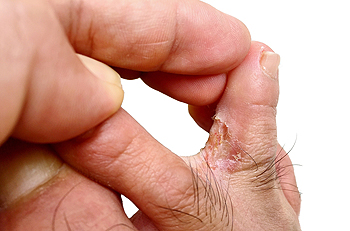July 2024
How to Prevent Athlete’s Foot
 Tinea, or fungal foot infections, commonly known as athlete's foot, occur when fungi thrive in warm, moist environments, such as between the toes. These infections are extremely contagious, spreading through direct contact with infected skin or surfaces like locker room floors and swimming pools. Individuals at a higher risk include athletes, those with compromised immune systems, and people who frequently wear tight, non-breathable footwear. Symptoms include itching, burning, and peeling skin, often accompanied by redness and blisters. To prevent tinea, it is important to keep feet clean and dry, especially between the toes. It is helpful to wear breathable shoes and moisture-wicking socks, change socks regularly, and use antifungal powders. Avoid walking barefoot in public places and ensure shoes fit properly to reduce risk. In persistent cases, prescription medications may be necessary. If you have developed athlete's foot, it is strongly suggested that you visit a podiatrist for proper management.
Tinea, or fungal foot infections, commonly known as athlete's foot, occur when fungi thrive in warm, moist environments, such as between the toes. These infections are extremely contagious, spreading through direct contact with infected skin or surfaces like locker room floors and swimming pools. Individuals at a higher risk include athletes, those with compromised immune systems, and people who frequently wear tight, non-breathable footwear. Symptoms include itching, burning, and peeling skin, often accompanied by redness and blisters. To prevent tinea, it is important to keep feet clean and dry, especially between the toes. It is helpful to wear breathable shoes and moisture-wicking socks, change socks regularly, and use antifungal powders. Avoid walking barefoot in public places and ensure shoes fit properly to reduce risk. In persistent cases, prescription medications may be necessary. If you have developed athlete's foot, it is strongly suggested that you visit a podiatrist for proper management.
Athlete’s foot is an inconvenient condition that can be easily reduced with the proper treatment. If you have any concerns about your feet and ankles, contact Dr. Eugenio Rivera from Calo Foot & Ankle Specialists. Our doctor will treat your foot and ankle needs.
Athlete’s Foot: The Sole Story
Athlete's foot, also known as tinea pedis, can be an extremely contagious foot infection. It is commonly contracted in public changing areas and bathrooms, dormitory style living quarters, around locker rooms and public swimming pools, or anywhere your feet often come into contact with other people.
Solutions to Combat Athlete’s Foot
- Hydrate your feet by using lotion
- Exfoliate
- Buff off nails
- Use of anti-fungal products
- Examine your feet and visit your doctor if any suspicious blisters or cuts develop
Athlete’s foot can cause many irritating symptoms such as dry and flaking skin, itching, and redness. Some more severe symptoms can include bleeding and cracked skin, intense itching and burning, and even pain when walking. In the worst cases, Athlete’s foot can cause blistering as well. Speak to your podiatrist for a better understanding of the different causes of Athlete’s foot, as well as help in determining which treatment options are best for you.
If you have any questions please feel free to contact our office located in Bellaire, TX . We offer the newest diagnostic and treatment technologies for all your foot and ankle needs.









